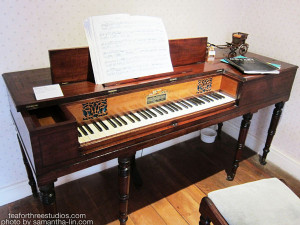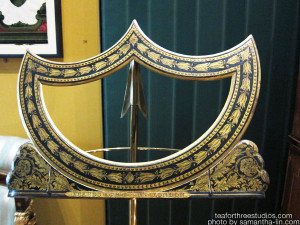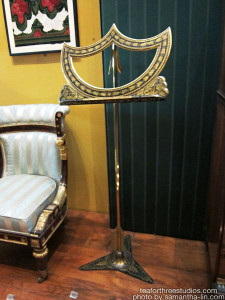It’s Samantha here, welcoming you to the first Friday Feature for our awesome April! This week, I want to talk a little about the music that was popular during the Regency era, primarily because it forms such an integral part of the context, gameplay, and stories in Regency Love. After all, it’s one of the accomplishments you can work on during your time in Darlington, and, should you decide to practise often, your musical prowess can be appreciated by all in your acquaintance.
Firstly, here are a few dates to get us started:
- 1811 – 1820: The Regency era, so named because the King at the time (George III) went a little bonkers and his heir, the Prince of Wales (later King George VI), ruled as the Prince Regent
- 1756 – 1791: The dates for Wolfgang Amadeus Mozart, whose music was pretty popular during the Regency
- 1732 – 1809: The dates for Joseph Haydn, who was very popular back in his days—even more so than Mozart, actually!
- 1770 – 1827: The dates for Ludwig van Beethoven, whose early style was quite “Regency-esque” (formally known as “Classical”), though he later developed a bolder style and broke many rules (in what’s formally known as “Romantic” music)
I’ve mentioned these three composers because their music was really popular during the Regency era, and was heard amongst the gentry everywhere: at concerts, public gatherings, and home.
Now, if we think about music in the Regency, we have to remember there was no way to experience any kind of music unless you—or someone in the vicinity—make the music. Which basically means you have to either attend loads of parties where music is played (by professional musicians or the guests themselves), or learn how to play and/or sing yourself. And of course, it’s important to practise a fair amount in order to play something other than “Twinkle Twinkle Little Star” (and I’m not talking about Mozart’s variations), and seeing as there was no Facebook or Tumblr to suck away your time, Regency folks would spend quite a bit of time working on their musicianship. If you think about it this way, then it makes more sense that women (and men) in the Regency were all crazily accomplished and could bang out a Beethoven sonata on request.
In fact, we have a lot of “drawing room” music going on in this era, where private gatherings (of any size) would consist of music performed by you or your friends. Most homes would have a pianoforte (which was a relatively new instrument at the time), or perhaps a smaller fortepiano (which was living its last days). Pianofortes became quite popular because they had enough range in both pitch (high and low notes) and dynamics (the louds and softs) to work as a solitary instrument, and because a lot of composers wrote for it (I guess the two are quite intertwined).

A pianoforte from Jane Austen’s House Museum in Chawton. The plate reads: “Square piano 1810. Piano made by Clementi in London. This may be similar to the piano that Jane bought after arriving here.”

When given permission to play this, I tinkled out a bit of Mozart—and “tinkle” is exactly the kind of sound this soft, delicate instrument produces.
Our protagonist in Regency Love, although not relatively well off, does have a pianoforte at home—nothing fancy, mind you, but a sturdy instrument Mama owned before she was married, and took with her to her new home. Unfortunately, printed music at the time was really expensive, and our protagonist doesn’t have any of her own. Instead, she borrows from her friends—mostly from Miss Mary Earlwood (what are BFFs for, if not to be your sheet music dealer?)—and she would either commit it to memory, or painstakingly copy down the music herself (or just not return it, though I’m sure Miss Earlwood would have a thing or two to say about that). Either way, it was important to have a few pieces under your belt, just in case you’re at a party and are asked to play. Besides, good musicianship is very attractive, especially to a potential husband: it reveals your particular tastes, shows you are refined and disciplined enough to spend all those hours practising, allows you to express your unique personality through music, and, most importantly, provides much delight. It’s actually for the last reason that Haydn more popular at the time than Mozart and Beethoven: while Wolfie and Wiggy sometimes wrote to impress and even to shock, Papa Haydn wanted to create pleasing music and treats for the ears.

The plate. A lot of the style and fashion during the Regency was inspired by those from ancient Greece, including the free-flowing dresses worn by the ladies.
Apart from what we now think of as “classical music”, the Regency drawing room was also home to a range of “popular” (though that term itself requires a lot of defining) songs, particularly those from beyond England. I’m especially referring to songs from Scotland and Ireland, of which the most popular works were by Robert Burns and Thomas Moore, respectively. Although some of the songs were a wee bit political, they were subtle enough to pass as love songs, or a quaint little piece about a (relatively) distant place. I’m personally a Thomas Moore fangirl (and admit to owning some nineteenth-century editions of his works), which is why you might see some Moore creeping into the Regency Love drawing rooms.

A copy of Thomas Moore’s Irish Melodies: Edition for Ireland (Dublin: James Cornish, 1857), which I found in the special collections of Trinity College, Dublin. The publication date is much later than Regency/Georgian, but Moore’s popularity started out during the Regency and had grown steadily since.
And so, I’ll leave you with a few examples of the kind of music heard at Regency gatherings (yes, this is absolutely an overt attempt on my part to spread some musical propaganda):
- Mozart’s Piano Sonata No. 5 in G major – we actually used the second movement (the andante) as a placeholder track in our early versions of the game
- Beethoven’s Piano Sonata No. 23 in F minor “Appassionata” – something a little heavier
- Hadyn’s Piano Sonata No. 59 in E-flat major
- Thomas Moore’s The Last Rose of Summer, Silent, O Moyle, and The Minstrel Boy (I couldn’t find a version of this with just a piano accompaniment on YouTube, but the CD I have of Moore’s Melodies is great, with Catherine Bott, Joseph Cornwell, and The Parley Of Instruments.)
What are some of your favourite Regency-esque pieces? Is there anything else you’d like to add? Please do leave us a comment—we’d love to hear from you!


Fun post – looking forward to more of this series!!!
I’m glad you enjoyed it–and I’ll certainly do my best! 😀
A very interesting post. I loved it and I can’t wait for the next one 🙂
Thank you for your lovely comment, and you’ll certainly be seeing more posts soon! 😀
Thanks for helping me with my research !